
The kimono is a traditional Japanese garment and the national dress of Japan. The kimono is a wrapped-front garment with square sleeves and a rectangular body, and is worn left side wrapped over right, unless the wearer is deceased. The kimono is traditionally worn with a broad sash, called an obi, and is commonly worn with accessories such as zōri sandals and tabi socks.

A sarong or a sarung is a large tube or length of fabric, often wrapped around the waist, worn in Southeast Asia, South Asia, Western Asia, Northern Africa, East Africa, West Africa, and on many Pacific islands. The fabric often employs woven plaid or checkered patterns or may be brightly colored by means of batik or ikat dyeing. Many modern sarongs have printed designs, often depicting animals or plants. Different types of sarongs are worn in different places in the world, notably the lungi in the Indian subcontinent and the izaar in the Arabian Peninsula.

The Boro, also called Bodo, are an ethnolinguistic group native to the state of Assam in India. They are a part of the greater Bodo-Kachari family of ethnolinguistic groups and are spread across northeastern India. They are concentrated mainly in the Bodoland Territorial Region of Assam, though Boros inhabit all other districts of Assam and Meghalaya.

A shawl is a simple item of clothing, loosely worn over the shoulders, upper body and arms, and sometimes also over the head. It is usually a rectangular piece of cloth, but can also be square or triangular in shape. Other shapes include oblong shawls. It is associated with the inhabitants of the northern Indian subcontinent—particularly Kashmir and Punjab—and Central Asia, but can be found in many other parts of the world.
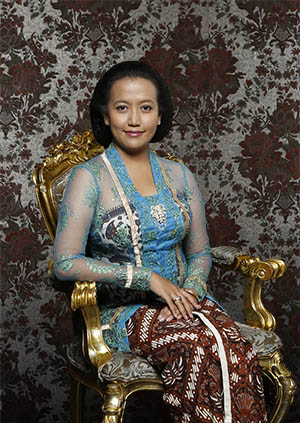
A kebaya is an upper garment traditionally worn by women in Southeast Asia, notably in Brunei, Indonesia, Malaysia, Singapore, and Southern Thailand. It is also worn in parts of southern Philippines and Cambodia.

Bodo–Kacharis is a name used by anthropologists and linguists to define a collection of ethnic groups living predominantly in the Northeast Indian states of Assam, Tripura, Meghalaya and West Bengal. These peoples are speakers of either Bodo–Garo languages or Assamese. Some Tibeto-Burman speakers who live closely in and around the Brahmaputra valley, such as the Mising people and Karbi people, are not considered Bodo–Kachari. Many of these peoples have formed early states in the late Medieval era of Indian history and came under varying degrees of Sanskritisation.

Boro culture is the culture of the Boro people in Assam. For long, the Boros have been farmers living in an Agrarian society with a strong tradition of fishery, poultry, piggery, with rice and jute cultivation, and betel nut plantation. They make their own clothing from scratch, such as traditional attires. In recent decades, the Boros are influenced by recent social reforms under Boro Brahma Dharma and the spread of Christianity.

In India, about 97% of the raw mulberry silk is produced in the Indian states of Karnataka, Andhra Pradesh, Tamil Nadu and West Bengal. Mysore and North Bangalore, the upcoming site of a US$20 million "Silk City", contribute to a majority of silk production. Another emerging silk producer is Tamil Nadu in the place in where mulberry cultivation is concentrated in Salem, Erode and Dharmapuri districts. Hyderabad, Andhra Pradesh and Gobichettipalayam, Tamil Nadu were the first locations to have automated silk reeling units.
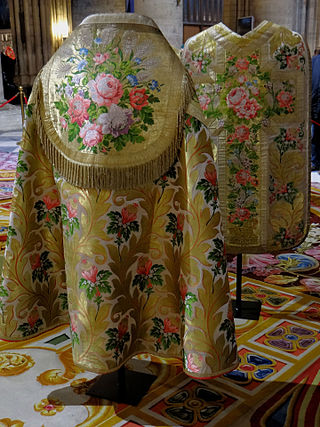
Brocade is a class of richly decorative shuttle-woven fabrics, often made in coloured silks and sometimes with gold and silver threads. The name, related to the same root as the word "broccoli", comes from Italian broccato meaning 'embossed cloth', originally past participle of the verb broccare 'to stud, set with nails', from brocco, 'small nail', from Latin broccus, 'projecting, pointed'.

Mekhela Sador is a traditional attire worn by women from Assam. Mekhela Sador is two-piece attire, the Mekhela and the Sador, and is generally made from silk such as Muga silk, Eri or Pat silk.
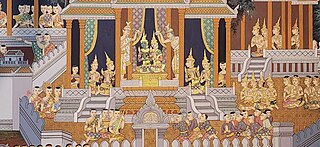
Khmer traditional clothing refers to the traditional styles of dress worn by the Khmer people throughout history. Tracing their origins back to the early Common Era, the customary styles of dress worn by Khmer people predate the indianization of Southeast Asia. The evolution of these clothing customs can be traced through archaeological artifacts from the 6th century to the post-Angkorian period, evolving from the simple pre-Angkorian Sampot to vibrant and intricately embroidered silk garments.
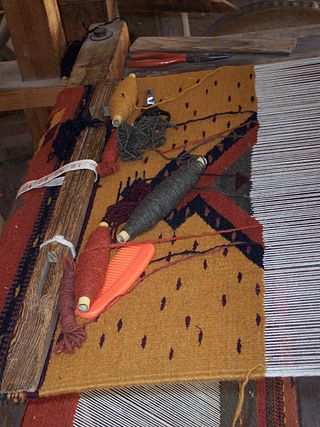
The state of Oaxaca in southern Mexico has a noteworthy tradition of finely crafted textiles, particularly handmade embroidery and woven goods that frequently use a backstrap loom. Oaxaca is home to several different groups of indigenous peoples, each of which has a distinctive textile tradition.

The Hajong people are an ethnic group from Northeast India and northern parts of Bangladesh. The majority of the Hajongs are settled in India and are predominantly rice-farmers. They are said to have brought wet-field cultivation to the Garo Hills, where the Garo people used slash and burn method of agriculture. Hajong have the status of a Scheduled Tribe in India and they are the fourth largest tribal ethnicity in the Indian state of Meghalaya.

The national costume of Indonesia is the national attire that represents the Republic of Indonesia. It is derived from Indonesian culture and Indonesian traditional textile traditions. Today the most widely recognized Indonesian national attires include batik and kebaya, although originally those attires mainly belong within the island of Java and Bali, most prominently within Javanese, Sundanese and Balinese culture. Since Java has been the political and population center of Indonesia, folk attire from the island has become elevated into national status.
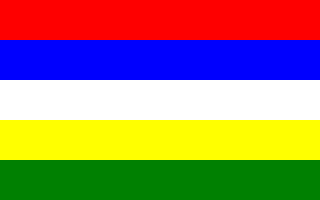
Bathouism is the folk religion of the Boro people of Assam in Northeast India. The name Bathou in Boro means five principles. The five principles are: bar (air), orr (fire), ha (earth), dwi (water) and okhrang (ether). The chief deity, called Bathoubwrai — omnipresent, omniscient and omnipotent— is said to have created the five principles. Though there are other minor gods and goddesses, Bathoubwrai is considered the Supreme God. Bathoubwrai is unseen. The second most important deity is Mainao, the daughter of Bathoubwrai, who is considered as the "protector of the rice fields".
Moran (Morān) is an extinct Boro-Garo language which was spoken in Assam in Northeast India and related to Dimasa language. The census returned 78 speakers in 1901, 24 in 1911 and none in 1931, and the only source of this language exists in a 1904 article by P R Gurdon. The speakers of this language have shifted to the Assamese language. The name "Moran" reportedly means 'forest dweller'.

The Chutia people are an ethnic group that are native to Assam and historically associated with the Chutia kingdom. However, after the kingdom was absorbed into the Ahom kingdom in 1523–24, the Chutia population was widely displaced and dispersed in other parts of Upper Assam as well as Central Assam. They constitute one of the core groups that form the Assamese people.

Pathin is a wrap-around skirt worn by the women of the Hajong tribe of the Indian subcontinent in Northeast India and Bangladesh. It covers the upper and lower part of the body from the bust until the calf of the leg. Women in the upper class wore a long pathin which would fall down to the floor while women in the lower class wore a shorter pathin whose length reaches to the ankle.
Dimasa is section of Kachari community. It belongs to Boro-Garo language family. It is mother tongue to around 500,000 Dimasa population. Large section of Sanskritised Dimasa speak Assamese language e.g. Sonowal Kachari, Thengal Kachari, Moran Kachari, Matak Kachari.

Yoruba clothing is the traditional clothing worn by people of the Yoruba ethnic group in parts of Nigeria, Benin and Togo in a region called Yorubaland. The clothing reflects the rich culture, history and aesthetic preferences of the Yoruba people.

























